
Edward Donald Slovik was a United States Army soldier during World War II and the only American soldier to be court-martialled and executed for desertion since the American Civil War. Although over 21,000 American soldiers were given varying sentences for desertion during World War II, including 49 death sentences, Slovik's death sentence was the only one that was carried out.
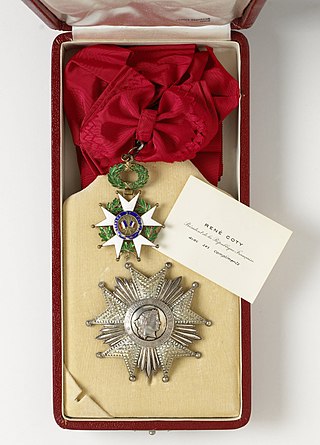
The National Order of the Legion of Honour, formerly the Royal Order of the Legion of Honour, is the highest French order of merit, both military and civil. Established in 1802 by Napoleon Bonaparte, it has been retained by all later French governments and regimes.

The Distinguished Service Cross (DSC) is the United States Army's second highest military decoration for soldiers who display extraordinary heroism in combat with an armed enemy force. Actions that merit the Distinguished Service Cross must be of such a high degree that they are above those required for all other U.S. combat decorations, but which do not meet the criteria for the Medal of Honor. The Army Distinguished Service Cross is equivalent to the Naval Services' Navy Cross, the Air and Space Forces' Air Force Cross, and the Coast Guard Cross. Prior to the creation of the Air Force Cross in 1960, airmen were awarded the Distinguished Service Cross.

Sergeant First Class Modesto Cartagena was a member of the United States Army who served in the 65th Infantry Regiment, a military regiment consisting of Puerto Rican enlisted soldiers and officers from the continental United States also known as "The Borinqueneers," during World War II and the Korean War, becoming the most decorated Hispanic soldier in that war. He was the most decorated Puerto Rican soldier in history.

Desmond Thomas Doss was a United States Army corporal who served as a combat medic with an infantry company in World War II.

The Medal of Valor is the Armed Forces of the Philippines' highest military honor awarded for a conspicuous deed of personal bravery or self-sacrifice above and beyond the call of duty that distinguishes the recipient from his comrades. It is defined in the Philippine Army Awards and Decorations reference material FC 1–0062, itself adapted from the Armed Forces of the Philippines Awards and Decorations Handbook, Second Edition published in 1997, as an award for "heroism in combat" and is foremost in the order of precedence of awards and decorations of the Armed Forces of the Philippines.

Sergeant Stubby was a dog and the unofficial mascot of the 102nd Infantry Regiment and was assigned to the 26th (Yankee) Division in World War I. He served for 18 months and participated in 17 battles and four offensives on the Western Front. He saved his regiment from surprise mustard gas attacks, found and comforted the wounded, and allegedly once caught a German soldier by the seat of his pants, holding him there until American soldiers found him. His actions were well-documented in contemporary American newspapers.

Chips (1940–1946) was a trained sentry dog for United States Army, and reputedly the most decorated war dog from World War II. Chips was a German Shepherd-Collie-Malamute mix owned by Edward J. Wren of Pleasantville, New York. He was bred by C.C. Moore, and was the son of Margot Jute, a half collie, half German shepherd, and Husky, a malamute.

Private First Class David M. Gonzales was a United States Army soldier who posthumously received the Medal of Honor — the United States' highest military decoration – for his actions during World War II. On April 25, 1945, at age 21, PFC Gonzales was killed in action in the Philippines while, in the face of enemy machine gun fire, digging out fellow soldiers who had been buried in a bomb explosion.

Leonard C. Brostrom was a United States Army infantry soldier who was killed in action near Dagami, Leyte, Philippine Islands, now the Republic of the Philippines, during the Philippines Campaign of 1944–45, in World War II. He received the Medal of Honor posthumously for his heroic actions above and beyond the call of duty. Brostrom was a member of and served a mission for the Church of Jesus Christ of Latter-day Saints before he entered the Army.

Hispanic Americans, also referred to as Latinos, served in all elements of the American armed forces in the war. They fought in every major American battle in the war. Between 400,000 and 500,000 Hispanic Americans served in the U.S. Armed Forces during World War II, out of a total of 16,000,000, constituting 3.1% to 3.2% of the U.S. Armed Forces. The exact number is unknown as, at the time, Hispanics were not tabulated separately, but were included in the general white population census count. Separate statistics were kept for African Americans and Asian Americans.
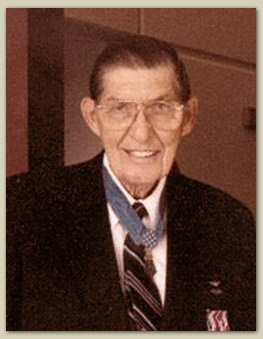
Van Thomas Barfoot was a United States Army officer and a recipient of the United States military's highest decoration—the Medal of Honor—for his actions in World War II.
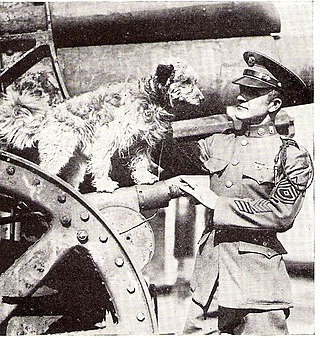
Rags was a mixed breed terrier who became the U.S. 1st Infantry Division's dog-mascot in World War I.

Carlton William Barrett, a native of Fulton, New York was a United States Army soldier who received the Medal of Honor for heroism near Saint-Laurent-sur-Mer, France on June 6, 1944, during the Normandy landings.
Asian Americans, who are Americans of Asian descent, have fought and served on behalf of the United States since the American Revolutionary War. During the American Civil War Asian Americans fought for both the Union and the Confederacy. Afterwards Asian Americans served primarily in the U.S. Navy until the Philippine–American War.

Lieutenant General Stanley Hamer Ford was a senior officer of the United States Army. After serving in numerous conflicts and wars, including World War I, He was commander of the Philippine Department, 1st Infantry Division, Seventh Corps Area, Sixth Corps Area, and the Second Army

Voltaire Tuvera Gazmin is a retired Filipino soldier who was the 35th Secretary of the Department of National Defense of the Philippines. Gazmin assumed office on 1 July 2010, after President Benigno S. Aquino III had issued the former's appointment the day before.
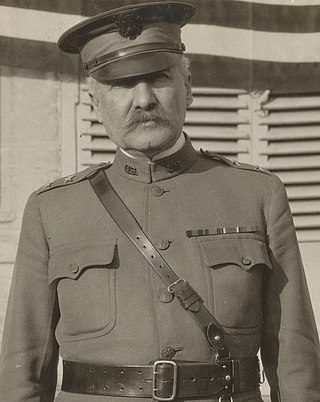
Major General George Windle Read was a senior United States Army officer who was prominent as a corps and division commander in World War I. Read also oversaw the departure of US forces from Europe at the end of the war as commander of the American Embarkation Center at Le Havre, France.
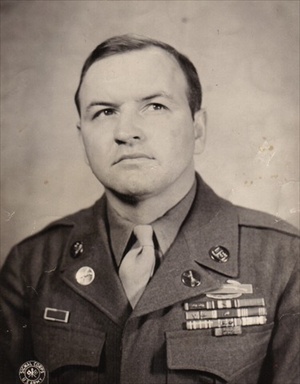
Llewellyn Morris Chilson was a United States Army master sergeant and one of the most decorated American soldiers of World War II. He received twelve individual decorations for combat from the U.S. Army including seven decorations for valor. After the war, the President of the United States personally decorated Chilson with seven decorations including three Distinguished Services Crosses for extraordinary heroism in Germany.

Romeo Saturnino Brawner Jr. is a Philippine Army general who has served as the 60th Chief of Staff of the Armed Forces of the Philippines since July 19, 2023. Prior to his appointment to the post, Brawner previously served as the 65th Commanding General of the Philippine Army and as the commander of the 4th Infantry Division in Northern Mindanao.



















